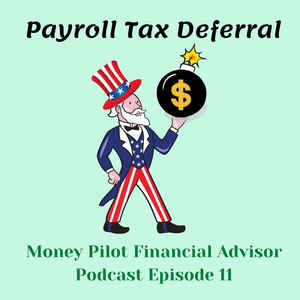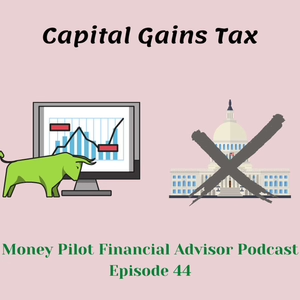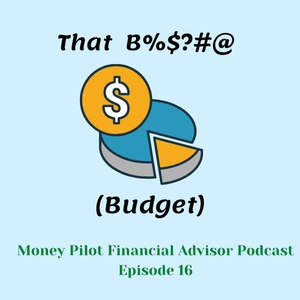
Money Pilot Financial Advisor Podcast
Kathleen "Katie" Cannon
All episodes
Best episodes
Seasons
Top 10 Money Pilot Financial Advisor Podcast Episodes
Goodpods has curated a list of the 10 best Money Pilot Financial Advisor Podcast episodes, ranked by the number of listens and likes each episode have garnered from our listeners. If you are listening to Money Pilot Financial Advisor Podcast for the first time, there's no better place to start than with one of these standout episodes. If you are a fan of the show, vote for your favorite Money Pilot Financial Advisor Podcast episode by adding your comments to the episode page.

Episode 11 Military Payroll Tax Deferral
Money Pilot Financial Advisor Podcast
09/15/20 • 11 min
Did you see a bit more money in your mid-month pay today? It may not be a raise. If you are a service member or federal employee, FICA Social Security taxes will not be withheld from you pay for the rest of the year. The bad news is that it may all have to paid back after the new year. Are you ready?
Joins us today to speak with special guest Adrienne Ross, founder of Clear Insight Financial Planning. She also wrote a blog on this topic for the Military Financial Advisor Association. Check it out!

Episode 71 Real Financial Planning
Money Pilot Financial Advisor Podcast
11/25/21 • 9 min
Today I we're talking about real financial planning. It's not hard to find financial advice. You can read books, look on the Internet, rumors, ask that crazy uncle. But I'm talking about a professional that has your best interest at heart of everything they do. The Certified Financial Planner Board describes financial planning as “looking at a client's entire financial picture and advising them on how to achieve their short- and long-term financial goals. From saving for education and planning for retirement to effectively managing taxes and insurance, financial planners develop valuable relationships with their clients to provide them with confidence today and a more secure tomorrow.” A good financial planner takes in all your information, does the math heavy lifting for you, and then comes back with a plan on how to achieve you goals. This holistic approach is good financial planning, and will give you the "What and the How" to help you accomplish your stated goals. When you seek out financial advice, your should absolutely look for this as a minimum.
But you don’t have to settle for just “good”. A real financial planner takes the time to explore your “Who and your Why”. They listen to your story, your passions, your way of doing things, and your fears. Who and what is most important to you? Why? They explore with you the life you want and what keeps you awake at night. Everyone has a different relationship with money. And we don’t check that at the door when we head into a meeting to discuss our financial goals.
Personal financial planning is personal. A financial plan developed from an short interview or questionnaire and review of your documents may result in a clear, detailed road map to a great financial destination. But is that your destination? Is it the best journey for you? Do you see yourself really carrying out this plan? Did you planner explore options, what ifs, or possible other paths with you? It takes time and most of all it takes great listening. When you walk out of a meeting with your financial planner or advisor you want to be confident they know what they are doing and that they are bound to put your best interest first. But you also need to know you were really heard. That your financial plan isn’t just a good financial plan. It’s YOUR plan. It’s the best plan for you and you see yourself in it.
If you’ve been thinking about getting some financial advice, you have choices out there. Most good financial planners offer a free introductory call or meeting, which is your chance to see they they might be a good fit for you. Ideally, they ask some open questions and really listen. If it sounds like a sales pitch, it probably is. And you can shop around. There are planners that you can hire by the hour, or for a specific project. Others like me work with clients on an ongoing basis to answer questions along way and reorient as your life’s journey evolves. Many advisors expect to manage and invest your money for you. Others like working with do-it-yourselfers by providing advise you can carry out yourself. I do both.
But finding a real financial planner comes back to you. Do they hear you? Do they invest the time to explore your who and your why? Do they “get” you and do you see yourself in the advice and planning they give back. If not, move on. You deserve better and it’s out there for you.
Here's some links to help your search for a real financial planner. My website, the Military Financial Planner Association, XY Planning Network, and the National Association of Personal financial Advisors.

Episode 20 Accidental Landlord
Money Pilot Financial Advisor Podcast
11/17/20 • 13 min
For most military and federal employees deciding whether you should rent out your home usually comes up because you have orders to move to a new duty station or will be going on a long deployment. We’ll talk about the decision to sell or rent out your house, and then if you do decide to rent at your home what should you consider. Selling your home up for sale and finding a buyer takes time, so start early. Ask will you be able to sell for profit, or at least get enough to pay off the mortgage. Remember there will be closing costs, repairs and getting house ready for sale, fees for the real estate agent which can easily add up to 10% of your selling price. If you would have to dip into savings to pay off the mortgage after you sell, consider renting out. If you think you’ll return, it may be easiest and most profitable to just rent it out while you’re away.
Ideally the rent will cover all of your expenses including the mortgage, insurance, property taxes, maintenance and repairs, finding new tenants, and paying a management company. Mortgage interest rates are low now, it may makes sense to refinance. Rates are lower for a primary residence than a rental property. So it may pay to refinance while you are still living the home. Lower monthly payments may be the difference in whether your rental income would be more than your expenses. Don’t assume the rent in your area would automatically be enough to cover all the expenses. Do some research to get a realistic idea of what rent you could expect.
Can you meet all your living expenses if the rental was vacant for a while or needed a major repair? Do you expect home values in the area to go up? If homes are sitting empty or if the local economy is floundering, it may be better to sell while you can. Are cut out to be a landlord? You, or a management company, will need to find a good tenant, receive applications, do credit check and criminal history checks and check references. And make a detailed written lease applicable for the state and local area where the house is located. This is important especially if you need to evict a tenant.
Remember you need rental home insurance, also called fire insurance. To caver the home itself. You should encourage tenants to buy their own renters insurance cover their things. And consider hiring a management company, especially if you’re a first time landlord. They can help with all these things we just talked about.
Another thing to consider is the tax you would pay on the sale of your home. If you have lived in your home for at least two of the last five years before you sell it, you will not pay any federal tax on the first $250,000 of profit if you’re single, or $500,000 if you’re married. For federal employees and military service members, time stationed overseas on orders doesn’t count. If you don’t meet that 2 of 5 year rule you will owe capital gains tax on the profits, typically 15%, depending on your tax bracket. If you plan on hanging to the rental property long-term, then the income and possible appreciation would probably offset at additional cost in taxes.
Home ownership and having rental property can be a great way to built wealth, your tenants essentially buys you a home over time. But it comes with extra risk and being a landlord isn’t for everyone. And depending on your particular circumstances, it may not give you a positive cash flow. Weigh your options and ability to pay any unexpected expenses that may come up with the rental home. And especially if this is the first time becoming a landlord, don’t hesitate to work with a management company to help with the process.

Episode 22 Value of Your Pension
Money Pilot Financial Advisor Podcast
12/01/20 • 13 min
Today we talk about what is government or military pension really worth. If you earn a military or federal government pension, you will receive a pension for the rest of your life, you can’t outlive it. You also get a cost-of-living allowance (COLA) based on inflation. A downside of the pension is that once you retire, that payment is set. You can’t increase it and only lasts for your life. Or if you participate in the Survivor Benefit Plan and die your spouse will receive up to 55% of your monthly pension for the rest of their life. Then that’s it. In contrast, investments like TSP can increase their value if you take on more risk. You may still have money left over in your TSP when you die they could pass on as an inheritance or gift to charity. But if you take less risk, like put money in the TSP G fund, your investments won’t keep up with inflation and you may run out of money before you run out of life.
What’s a pension really worth? One way of looking at it is to calculate its present value. The calculations are bit complicated, but generally the present value of your pension is the lump sum amount of money you need if you retired today, invested that lump sum at a certain interest rate, then drew out and spent the amount of your yearly pension, for set number of years.
If you are military E7 with over 20 years of service, or a GS 8/9, your annual pay is about $59,000. The service member serves 20 years and retires at 42 getting 50% of base pay in retirement, of just under $30,000 and can expect to live another 40 years. The present value of their retirement pay is over $750,000. The federal FERS GS 8/9 employee retiring at 57 with 30 years of service would have a yearly retirement pay of almost $20,000 and live another 26 years. The present value of their retirement pay is almost $380,000.
For Officer 05 retiring at 42 with 20 years of service, their yearly retirement pay would be $57,000. The present value of that is almost $1.5 million. For FERS GS 13/14, retiring at 42 with 30 years of service to about $730,000, with 40 years of service almost $975,000. As you decide whether to stay or whether to go this can give you a hard dollar figure to help you decide if it’s worth it for you to stay.
The military BRS and federal employees FERS retirement systems are based on a triad of the traditional pension we been talking about, Social Security, and the Thrift Savings Plan. I like to look at these planning for retiremen by, dividing your expenses in retirement in two NEEDS and WANTS. Needs would include food, housing, healthcare, taxes, transportation, etc. Estimate each of these costs for total dollar figure. Ideally your pension and eventually Social Security will cover those needs. This is your safety net. What if those needs are more than your pension? Consider ways to reduce those expenses. For everything else, your wants, you could cover these with your investments like TSP. If you take some risk (volatility) your investments can grow faster than inflation so buying power increases. This provides flexibility and maybe a nicer lifestyle. In years where there value is dropping, don’t draw from it or don’t draws much. Spend a little bit less on the wants, knowing your needs are covered by your pension and Social Security. Then when things bounce back you can go back to spending more on your wants again.
One area to look as you get closer to retiring is you may have a gap in “guaranteed” income between t receiving your pension and drawing Social Security. Also keep in mind some expenses like healthcare tend to rise faster than inflation. Over time your pension may not cover all your needs. This is where Social Security might help with some of those expenses. If you have any questions or are curious what the present value of your particular pension would be, just reach out to me at Katie that’s [email protected]

Episode 46 FERS Retirement Date
Money Pilot Financial Advisor Podcast
05/19/21 • 11 min
Today we're going to talk about what age to retire if you're a FERS federal employee. There are several key ages to consider. The first is when will you reach your minimum retirement age (MRA). Depending on when you were born your MRA is from 55 to 57 years old. If you have at least 30 years of service, you can retire at your FRA and start receiving your pension immediately. If you have more than 20 years but less than 30, you are eligible for a full pension, but you won’t begin get your first pension payments until you are 60 years. If you have 10 to 29 years federal service, you are eligible for a retirement at your full retirement age, but your pension payments will be permanently reduced. This means you’ll have a gap where you won’t have your federal salary or a pension for a few years. Or you could retire early and start a pension immediately, but you payments will be permanently lower.
The next key age is what we call the “magic 62”. You'd be eligible to begin receiving your Social Security at age 62. I don't usually recommend you do that. But it's an option, it gives you flexibility if you need it added income right away. In general, your Social Security full retirement age is between age 65 and 67, depending on when you were born. That’s about 10 years after your FERS minimum retirement age. Retire before you Social Security full retirement age and you will get a permanently reduced benefit. On the other hand, if wait until you are 70 to start Social Security you will get 8% more in your paycheck for each year past full retirement age.
Another reason to wait until at least magic 62 to start your FERS retirement is a boost to your FERS pension. If you're a FERS employee with more than 20, but less than 30 years of service, you get an extra bonus by waiting to 62. Your yearly pension is calculated by multiplying your average high-three yearly salary, times 1%, times your years of service. But if you wait until you're at least age 62, with 20 years or more of service, you use 1.1% in the formula instead of the 1%. Y
Another great benefit of waiting to age 62 is that's that’s the age when your regular FERS retiree Cost of Living Allowances (COLA) begin. COLA is a yearly automatic increase in your retirement pension based on inflation. If you retire before age 62, you miss out on those COLAs. The buying power of your pension will go down because of inflation until age 62. You never get a catchup for those years.So again, getting that COLA boost every year right from the start is another plus for waiting till you're age 62.
All right. Now there also are general benefits of retiring later. The longer you work, the better off you are financially, because you're saving longer, earning a higher FERS and Social Security pension, and putting off spending your retirement savings until you're older. It helps you build a cushion.
And, of course, there's the Thrift Savings Plan. You FERS employees are getting that 1% contribtion from Uncle Sam no matter what. And then if you're contributing to TSP you get up to a 5% salary match. If you're contributing the max $26,000 a year when you’re 50 or older, with your match, that's an extra $31,000 a year in TSP for every extra year you work, and that can add up fast as well.
So in deciding when to retire, are you enjoying your work, how’s your health, and how much do you need for a pension to have the retirement that you want. You can run the numbers and find the best plan for you. Look at your possible income sources like your federal pensions, Social Security, and Thrift Savings Plan and the costs and benefits of tapping each one at different ages. Everybody's situation is unique. But it’s good to remember and consider the benefits of that waiting until your are 62 or later to start retirement.

Episode 43 Save More
Money Pilot Financial Advisor Podcast
04/27/21 • 17 min
In Episode 39 Stash the Cash we talked about different cash accounts you can use for short term savings goals, like savings accounts, CDs, and money market accounts. Today, we’ll ask What Account Should I Consider If I Want To Save More. I put a free, handy checklist that you can download from my website at www.moneypilotadvisor.com.
Healthcare savings plans offered by employers. These aren't available to our military service members insured with TRICARE. These special savings accounts allow you to put pre-tax dollars in them directly from your pay check. And as long as you use the funds to pay eligible medical expenses, you won’t pay tax on the money when you draw it out either. With the Flexible Savings Account (FSA) you and your employer can make contributions. But remember to spend the money in your FSA each year because you can't carry it over.
Health Savings Account (HSA) You can only use one if you have a high deductible health plan. Again, not available with TRICARE. Many civilian employers and FEHB do offer them. It is like an FSA but you can carry over your balance from year to year. If you still have money in your HSA at age 65, you can withdraw it for any reason tax free. It's the Triple Crown of tax free. Consider keeping at least that max out-of-pocket amount in your HSA and/or emergency savings to cover you if you have a big expense.
Retirement savings accounts like a 401(k), 403(b), or the Thrift Savings Plan (TSP). Contribute enough to max out any match offered by your employer. For FERS employees and BRS military service members that's at least 5% of your pay. CSRS feds and non-BRS military don’t get a match. Everyone else check with your employer.
Everyone with earned income contribute to an Individual Retirement Account (IRA) and if you’re a couple with only one income, you can still save up to the max for each of you. This is a great way for a non-working spouse to build up retirement savings. There are regular r and ROTH IRAs. There’s a lot to it. Learn more in my Podcast Episodes 28, 29, and 30 .
529 College Savings Plans. 529s are offered by almost every state. Withdrawals are tax-free if used for qualified education expenses. And you can change always the beneficiary if needed. Many states also offer other incentives that sweeten the 529 pot so it's worth checking out the details for your state.
Tax Deferred Insurance either an annuity ora cash value life insurance policy, like whole life or universal life Insurance. I feel like both of these though should come with a warning label. They're not necessarily bad saving vehicles. But they often offer large commissions to the agent that sells them and all too often our sold to people when they are not appropriate. So if you're considering an annuity or cash value life insurance, this would be a great time to get a second professional opinion from a financial planner to see if other savings vehicles and or cheaper term life insurance may better fit your particular needs.
Lastly, consider a taxable brokerage account. Generally, you can take your money and use it when and where you want without a penalty. These accounts are good if you are willing to take some risk, plan to leave the money there for at least a year, and want would like to earn more return than cash accounts. Setting up these accounts doesn't have to be intimidating. You can usually set up an account online with a low fee mutual fund company like Vanguard, or Betterment which helps you invest in low cost ETFs. Even bigger name brokerage houses like Charles Schwab have some simple, low fee options. If you want someone else to handle it all for you or advice on what to invest in, this is another good time to call on a fee-only financial planner or advisor.

Episode 38 Tax Drama
Money Pilot Financial Advisor Podcast
03/24/21 • 8 min
Hi everyone and welcome to tax season. A few days ago, the Internal Revenue Service announced that the federal income tax filing due date for individual 2020 returns and payment of income tax has been automatically extended from April 15 to May 17, 2021.
You get an extra month to file and pay your federal income tax. They are now both due on May 15. But this does NOT mean that your State income tax filing deadline is automatically extended (if you’re state has an income tax). Some states already have deadlines later than May 17, and MAY not be affected. The rest of the states are deciding what to do and have been making announcements. California, Virginia, North and South Carolina, are among the states that have already extended their deadlines to May 17th and more are making the decision. Check with your state for the latest specifics. The states I mentioned have also said the deadline to pay the state income tax was also extended, but don’t assume that is true for all states. Double check.
In another late minute change, if you received unemployment income in 2020 and your AGI was below $150,000 , you won’t pay federal income tax on the first $10,200 of unemployment you received. If this affects you, but you have already filed your 2020 tax return, do not file an amended return just for that. The IRS put out guidance that they will re-figure your taxes using the excluded unemployment amount and adjust your account accordingly. The IRS will send any refund amount directly to you.
If this affects you, you haven’t filed yet, and you live in a state with a state income tax, may want to wait a few days or a week. Tax preparation software is rapidly catching up with the states’ changes as they are announced. But we noticed an anomaly on Saturday in the in software we use where the fix for the federal returns, inadvertently caused an error in the calculation of the state return. If you are doing your own tax prep, give the software a bit of time to make the changes and be sure to update it the software before you send in your electronic return. If you use a tax preparer they should be on top of this already.
Should you wait until May 17 to file? if you don’t have a compelling reason to put it off and you are expecting a refund filing sooner will mean you get your refund faster.
Even with the extensions to file your federal tax return, will you be unable to pay your taxes on time? FILE anyway. Remember the penalty for failure to PAY your taxes is 0.5% per month plus interest. The penalty for failure to FILE by the extended deadline is 5% per month. Yes the penalty for not filing on time is 10 times more than the penalty for not paying your on time.
Do you have special circumstances and you can’t file on time? No problem, before the new May 15 deadline, file for an extension with IRS FORM 4868. Individual taxpayers can request a penalty free-extension before the filing deadline and then actually file your return by October 15. But understand the deadline to pay your taxes will not be extended past the May 17. And again if your state has an income tax, check with your state for any special rules or extensions.
One special note, especially for our listeners who pay quarterly estimated taxes. Your 2021 estimated tax payments did NOT get an extension. If you're required to make estimated quarterly tax payments to the IRS because you are self-employed, have rental property, or have investment income or other reasons, you still need to make those payments at the normal times which is still April 15 for 1st quarter 2021 and June 15 for the second quarter payments. This is different than last year when they were extended. So remember get those estimated 1st quarter payments in by 15 April as normal.
Hope this has cleared the air a bit and we’ll speak with you next time.

Episode 48 Bridge the Gap
Money Pilot Financial Advisor Podcast
06/01/21 • 17 min
This week, we're going to talk about how to bridge the gap if you've decided you want to try something you've always dreamed about, find a different career, or just take a much needed break. When planning for this, think what do you want this gap to be and for how long. Then come up with a budget for that gap. Your current budget is a good place to start, then make adjustments.
Another key budget consideration is health insurance. This is NOT the place to skimp. It's not worth putting your whole financial future at risk by skipping health care insurance. This can be a bit of a challenge, but there are options. For example, if you're in the military you're when you transition out, you’re eligible for the Continued Health Care Benefit Program,but it is quite expensive. Anyone, can shop for health insurance on healthcare.gov. There's different plans you can choose from and you may qualify for a tax credit to pay for some of the premium costs.. You will need to know where you plan to home base, because these plans vary by state. If you're healthy you may save money selecting a high deductible health plan. Your premiums would be lower in exchange for paying more out of pocket expenses and having a higher catastrophic cap
Next consider life insurance. If you have someone you support financially who would struggle without your income when you pass, like children and or a spouse that has been out of the workforce awhile, or is earning a lower income, you need to plan for continuing life insurance during your gap. If you are meeting that need now with workplace group life insurance like SGLI or FEGLI, you will need to buy life insurance before you start your gap. Term life insurance policies are usually quite reasonably priced.
Once you've developed a budget for your gap t, look at how much time you have until your gap starts, and put a dollar figure on much you need to save from each paycheck to get there.
The last big decision is what to do with those savings until you need them. If you're one to three years out from your gap, the best thing to do is save that money in an FDIC insured bank account. That can be a savings account, a money market account at a bank, or certificates of deposit.
If your gap is more than three years away depending on your tolerance for risk and whether you've got flexibility in the timing of your gap, you may earn a higher return. But that means taking some risk. Bonds are often a good choice for these sort of mid-term goals. Your returns will fluctuate, but not as much as stocks. Stock are riskier, but on average provide even higher returns. It's helpful to have some flexibility in timing your gap. If for instance, you're able to just put it off a year, you can continue saving, and that gives time for the markets to rebound a bit. And then you could get that back in line and probably even exceed your initial goal. If you can wait.
A good vehicle for doing this saving into low cost index funds. You can buy these funds directly from a mutual fund company or open a brokerage account Another option is Betterment. They invest your savings in low cost index funds that track an entire stock and bond market, just tell them what percentage to invest in stocks and what percentage to invest in bonds. Vanguard has Life Strategy Family Funds look at how much time you have until you need your savings, then invest in mutual funds for you.
I hope you’ve enjoyed my podcasts on funding a gap. I’d love to hear about your dreams for a transition or gap and how you will save for it. If you’d like some help with the planning reach out for a free consultation. I love helping you live your dream life.

Episode 44 Capital Gains Tax
Money Pilot Financial Advisor Podcast
05/04/21 • 18 min
Profits on investments can be taxed as regular income or at a lower long-term capital gains tax rate. Capital assets are things you buy, hold, and then sell, like stocks, bonds, mutual funds, Exchange Traded Funds (ETF), collectibles, and real estate property. Its increase in value is called gain. Capital gains are taxed when they are sold. You calculate gain by subtracting what you paid, called basis, from what you sell it for. To be long term you have to hold it for one year or more. If you buy a capital asset l, hold it for one year or more, then sell it for more than you paid for it, you have a long-term capital gain. You will owe tax on it, but the tax rate you pay will be lower than regular income tax.
Long term capital gains (LTCG) are taxed at 0%, 15%, and 20%. In 2020, if your total income was up to $40,000 if you’re single, or $80,000 MFJ your LTCG are taxed at 0%! Over that up to $400,000 plus you’re LTCG will be taxed at 15%. If you are expecting a drop in income that would put you in the 0% LTCG tax bracket, like taking some time off from work after transitioning out of the military, retiring early before you are eligible for a pension or social security, or are between jobs, this may be a good time to realize a LTCG. If you sell while you are in the 0% LTCG bracket, you pay no tax on it. You can reinvest it in something else and reset your basis, paying less tax overall than if you let that initial investment ride. Even if you won’t be in the 0% LTCG bracket, the LTCG rate is always lower than your federal income tax bracket, with a couple of exceptions that I’ll cover below.
Here are a few things that are NOT long-term capital gains. Regular dividends and interest from investments you own are taxed as regular income. If you sell an asset you held for less than one year, it is a short-term capital gain and will be also taxed at your higher regular income rate.
If you sell an asset for less than you paid for it, it is a capital loss. You can subtract your losses from your gains in the same year to determine your tax. If you have an overall gain, you pay tax on the difference. If you have an overall loss of, you can deduct up to $3,000 of it from your regular taxable income. The rest of your losses have to be “carried over” to the next year.
A special category is the sale of a your home. Up to $250,000 of gain if you are single, $500,000 of gain if married is not taxed if you lived in your home for 2 of the last 5 years before you sold it. Our military can have up to 10 years to meet the requirement if you PCS . And federal employees suspend the 5-year clock while they on government orders overseas . .
There’s not enough time today to go into the sale of a rental property which is also subject to LTCG tax. But know that improvements to the property are added to basis. And when sold you will pay a special 25% capital gains tax on all the depreciation deducted from your taxes over the years, called unrecaptured depreciation.
The last special rule is the LTCG rate for some assets are taxed at a flat 28% , no matter your income . This includes collectibles like art, stamps, coins, cards, comics, other rare items, and antiques, as well as precious metals in any form. If you are a high earner in the 32%, 35%, 37% income tax brackets, the LTCG tax rate of “just” 28% is still a good deal. But for most Americans, the 28% LTCG rate for this special category of assets is HIGHER than your regular income tax rate.
Lastly, keep detailed records of how much you pay for your assets. If you are buying and selling assets with a broker-dealer, bank, or mutual fund they will issue you a FORM 1099-B each year that will list the sales details and basis and you just plug that into your tax return
IRS Topic No. 409 Capital Gains and Losses https://www.irs.gov/taxtopics/tc409

Episode 16 That Budget
Money Pilot Financial Advisor Podcast
10/20/20 • 18 min
Today, I thought we'd talk about that B word. You know what I mean. The budget. I don't even like that word, it just brings back memories of somebody telling me what to do with my money. And let's face it, we work hard for our money, we don't want somebody else telling us what to do. It's my life, it's my money, right? Same for you.
The first thing I usually do with clients when we're talking about the B word is really getting a good feel for what your values are. I give them a sheet of values circle the different ones, you might just think of it off the top of your head. But I encourage you to just sit down and just take a little bit of time. Things that might be on your list could be community, contentment, creativity, humanitarianism, hard work, originality, relationships, or one of may others.
So once we've got your values in life, it's then time to really nail down the values of your budget. That is the numbers, how much money's coming in, and how much money's going out, and where it's all going. A great way to do this is with objects that represent a certain amount of dollars. I use 2 different color blocks. You could use peanuts and almonds if you want.
First write each of your monthly expense categories on a card and fold it in half so it will stand up like a tent. Assign a dollar value to each green block, peanut, or whatever you're using. Let's say one block is worth $15. Divide your monthly income by that amount. So if you earn $2,600 a month, that's about 173 blocks. Count out 173 green income block. Then the number of blocks/nuts in front of each card that represents that expense. So if you rent is $1,500/mo that's 100 block in front of that card. Do that with all your expense categories. Do you run out of blocks before you run out of expenses? Then use yellow blocks, or almonds if your using nuts. This will make any shortfalls stand out.
Now step back and really look at it. Think back to your top 5 values you wrote down earlier. Do these piles reflect your values and what's important to you? Can you rearrange them by cutting in some places and adding more to other expenses to better meet your values and eliminate the yellow blocks. Put the new dollar amounts on the other side of each expense card. Here's you new, special you, budget.
Does your income or expenses change? Do the exercise again. Priorities and goals shift? Repeat. Keep going this way in life and you can put YOUR money where YOUR heart is.
Want to buy a kit to use? Maybe you ate some of your peanuts? You can purchase one here:
https://livewealthynow.com/shop/
Other resources , lke the Values Worksheet can be downloaded here:
https://livewealthynow.com/resources/
I love questions and suggestions for upcoming podcasts. Please reach out to me at [email protected]
Or on our website:
https://www.moneypilotadvisor.com/
Show more best episodes

Show more best episodes
FAQ
How many episodes does Money Pilot Financial Advisor Podcast have?
Money Pilot Financial Advisor Podcast currently has 87 episodes available.
What topics does Money Pilot Financial Advisor Podcast cover?
The podcast is about Money, How To, Financial, Budget, Invest, Podcasts, Finance, Self-Improvement, Education, Planning, Government and Military.
What is the most popular episode on Money Pilot Financial Advisor Podcast?
The episode title 'Episode 85 Join the Party' is the most popular.
What is the average episode length on Money Pilot Financial Advisor Podcast?
The average episode length on Money Pilot Financial Advisor Podcast is 12 minutes.
How often are episodes of Money Pilot Financial Advisor Podcast released?
Episodes of Money Pilot Financial Advisor Podcast are typically released every 7 days.
When was the first episode of Money Pilot Financial Advisor Podcast?
The first episode of Money Pilot Financial Advisor Podcast was released on Mar 18, 2020.
Show more FAQ

Show more FAQ